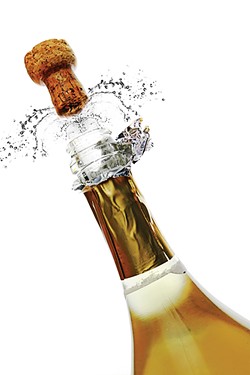In my opinion, any day is a good day for Champagne. However, for those who need an official reason to celebrate bottled bubbles, Oct. 23 is Global Champagne Day. From Australia to Paris and Hong Kong to Rio, Champagne toasts will be in abundance. A number of restaurants and bars throughout the country—STK in Las Vegas is the closest to Salt Lake City—will offer complimentary glasses of Champagne to their guests. Sadly, freebies are discouraged here by the UDABC, and I know of no local restaurants participating in the complimentary Champagne toast.
But what of this stuff called Champagne? If you've sipped Champagne only at weddings, you might not be all that fond of it, since it was likely either Gobi Desert-dry to toothache-sweet.
First things first, though: Champagne is wine. To be called "Champagne," it has to come from the Champagne region of France, about 90 miles northeast of Paris. California and other winemaking regions might produce excellent sparkling wines—wine with bubbles—but they are not Champagne. There are approximately 110 producers of Champagne in France—called "maisons" or houses—most based in Reims and Epernay.
Like most still wines—Sauvignon Blanc, for example—Champagne isn't just one thing. It ranges widely in style and type, from very light to full-bodied and, as mentioned, from bone-dry to sickly sweet. The most popular and common type of Champagne is golden-colored, and made by blending three Champagne-grown grapes: Chardonnay, Pinot Noir and Pinot Meunier. Also produced in Champagne are three other types: Blanc de Blancs, Blanc de Noirs and Rosé Champagnes.
Blanc de Blancs ("white from whites") Champagnes are made solely from Chardonnay grapes, a style created by the founder of Salon Champagne, Eugène-Aimé Salon. Salon is the best Blanc de Blancs on the planet, and probably the most expensive. Taittinger and Krug are other consistently excellent producers of Blanc de Blancs.
Somewhat rare, even in the Champagne region itself, Blanc de Noirs ("white from blacks") is a pink-hued Champagne style made entirely from black grapes, usually Pinot Noir and/or Pinot Meunier. The House of Bollinger is France's premier Blanc de Noirs Champagne producer.
Rosé Champagne is my personal favorite style, and after spending a week in Reims and Epernay, I really learned to love it with a wide variety of foods, from foie gras to a lunchtime croque-monsieur sandwich. Rosé Champagne is a blend of Pinot Noir and Chardonnay, but can vary greatly in ratio from producer to producer. You can find full-bodied Rosé Champagne that's as much as four-fifths Pinot Noir, or a light, golden version that's four-fifths Chardonnay—amd anything in between. I like the Rosè Champagnes from Roederer, Gosset and Moët & Chandon.
As with most wines, it's a good idea to read the labels on Champagne bottles. How else would you know if you're buying sweet or dry (non-sweet) Champagne? For practical purposes, Champagnes are ranked and labeled according to sweetness or dryness. From least sweet (more dry) to most sweet (least dry) the categories you're most likely to find are these: Brut (dry), Extra Dry (medium dry), Sec (slightly sweet), and Demi-Sec (which, perhaps counterintuitively, means very sweet). There are also extreme categories at both ends of the spectrum—Extra Brut (extremely dry) and Doux (extremely sweet)—but coming across these champagnes is relatively rare.
To celebrate Global Champagne Day, I suggest picking up a few bottles of the various styles of Champagne, varying in sweetness and dryness, and pop the corks with friends and family. À votre santé!
More by Ted Scheffler
-
Flavor on the Western Front
Nomad Eatery ups the ante for off-airport eats.
- Dec 13, 2017
-
Under the Christmas Tree
Holiday gifts for cooks, foodies and winos
- Dec 6, 2017
-
Spreading the Love
Amour Café creates simple yet scrumptious fare.
- Nov 29, 2017
- More »





